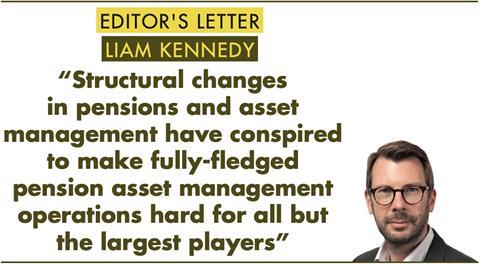The late Jack Welch, CEO of General Electric for two decades until 2001, was not only a legendary businessman who grew GE’s market cap 30-fold over his tenure. He also inspired a minor revolution in pension fund management that dates back to the days of mainframe computers and telex machines.

In 1988, the in-house pension fund management of GE’s sprawling corporate empire was recast as GE Asset Management, creating not only a competence centre but also a revenue-generating unit. These were the days of the mega buyouts and junk bonds – 1988 was the year KKR wrested control of RJR Nabisco.
Pensions were to undergo a revolution in the decade or so that followed, as trustees were advised to diversify and outsource to a roster of best-in-class managers.
Watching GE’s move and advised by their consultants, many corporate sponsors of defined benefit pension plans sought to improve their internal management in the 1990s and 2000s, with the likes of Unilever and Nestlé building large-scale company-wide pension management operations.
But for multinational groups there was often a tension between the corporate centre and the fiduciaries of the various corporate schemes in different countries – independent-minded local trustees did not always want to use the central capabilities offered by the sponsor.
Only a few corporates followed GE in creating a fully-fledged asset management operation open to third parties, including Philips and KLM in the Netherlands and BT in the UK.
Philips’s Schootse Poort asset management operation was short lived and was outsourced to BlackRock in 2006, while the trustees of the BT Pension Scheme sold Hermes to Pittsburgh-based Federated in 2020.
Other internally focused entities also did not last long; Nestlé Capital Management, created in 2006, was outsourced to BlackRock in 2017.
Elsewhere, changes in the structure of DB liabilities (shorter investment horizons, less risk tolerance) have meant asset management capabilities focused on traditional asset classes, like equities and bonds, have become obsolete.
Pension funds now require a skill set either in risk management and liability-driven investment (LDI) if the goal is insurance risk transfer in the near term, or in private market assets and alternatives if the objective is for a self-sustaining scheme with a sufficient risk horizon. Schemes eschewing costly buyouts need different skills altogether.
In the UK, BA and British Gas have outsourced their capabilities in recent years.
In the Netherlands, the asset management operation of the KLM pension schemes, Blue Sky, is one of the last of its kind. It is now on the market, although it will continue in business as an administrator, including for non-KLM entities. With assets under management of around €25bn, Blue Sky was a minnow in comparison with the behemoths of the Dutch industry-wide pension sector – APG, PFZW and MN.
Structural changes in pensions and asset management have conspired to make fully-fledged pension asset management operations hard for all but the largest players, and most either focus on one client or manage a limited volume of third-party client assets. While outsourced CIO (OCIO) and fiduciary management doubtless has a strong future, the strongest players are likely to be the largest.
Costs have risen in recent years in the asset management business, driven by the need for technological investment and regulatory compliance, while fee revenue has been compressed by cost-conscious buyers and the rise of passive funds. Unlike fully commercial entities, pension-focused entities do not have the pipeline of new business needed to increase scale to outpace costs.
Deciding between outsourcing and building in-house competence has long been a vexed question. What should corporate pension sponsors and trustees do? There is a strong case for an increased focus on strategic asset allocation as a core competence – both for DB schemes and within emerging DC funds. Research on Dutch pension funds suggests they have neglected this key area of strategy (see Netherlands report in this issue).
Pension empire building might have been attractive in the 1980s and 90s for the disciples of Jack Welch. But GE Asset Management itself only lasted 28 years until 2016, when assets totalling around $100bn were oursourced to State Street Global Advisors.
With the decline of DB there are good reasons to assume that few corporates will see pension management and administration as a centre of competence in the future. Most sponsors should get a good return on investment by ensuring they have sufficient in-house expertise in the form of a knowledgeable and committed trustee board supported by in-house capabilities focused on strategy and execution.
Liam Kennedy, Editor
liam.kennedy@ipe.com

























